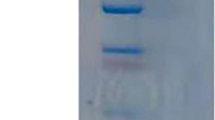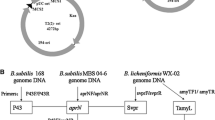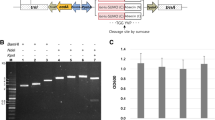Abstract
Plectasin, the first fungus defensin, is especially efficient against Gram-positive bacteria. To explore an effective approach for expressing plectasin in Bacillus subtilis, the sequence encoding plectasin fused with the small ubiquitin-like modifier (SUMO) gene, the 6 × His gene and the signal peptide of SacB were cloned into an E. coli–B. subtilis shuttle vector pGJ148 in which the maltose utilization operon promoter Pglv directed the expression. The fusion protein successfully secreted in culture and approximately, 41 mg of the recombinant fusion protein SUMO-plectasin was purified per liter of culture supernatant. After purification by Ni-NTA resin column and digestion by SUMO protease, 5.5 mg of plectasin with a purity of 94 % was obtained from 1 L fermentation culture. Recombinant plectasin was found inhibition activity against S. pneumoniae, S. aureus and S. epidermidis. These results indicate that the maltose-induced expression system may be a safe and efficient way for the large-scale production of soluble peptides in B. subtilis.




Similar content being viewed by others
References
Cao Y, Ma Q, Shan A, Dong N (2012) Expression in Pichia pastoris and biological activity of avian β-defensin 6 and its mutant peptide without cysteines. Protein Peptide Lett 19:1064–1070. doi:10.2174/092986612802762660
Chen X, Shi J, Chen R, Wen Y, Shi Y, Zhu Z, Guo S, Li L (2014) Molecular chaperones (TrxA, SUMO, Intein, and GST) mediating expression, purification, and antimicrobial activity assays of plectasin in Escherichia coli. Biotechnol Appl Bioc. doi:10.1002/bab.1303
Chen X, Zhu F, Cao Y, Qiao S (2009) Novel expression vector for secretion of cecropin AD in Bacillus subtilis with enhanced antimicrobial activity. Antimicrob Agents Chemother 53:3683–3689. doi:10.1128/AAC.00251-09
da Costa JP, Cova M, Ferreira R, Vitorino R (2015) Antimicrobial peptides: an alternative for innovative medicines? Appl Microbiol Biotechnol 99:2023–2040. doi:10.1007/s00253-015-6375-x
Dong N, Zhu X, Chou S, Shan A, Li W, Jiang J (2014) Antimicrobial potency and selectivity of simplified symmetric-end peptides. Biomaterials 35:8028–8039. doi:10.1016/j.biomaterials.2014.06.005
Hancock REW, Sahl H-G (2006) Antimicrobial and host-defense peptides as new anti-infective therapeutic strategies. Nat Biotechnol 24:1551–1557. doi:10.1038/nbt1267
Hara S, Mukae H, Sakamoto N et al (2008) Plectasin has antibacterial activity and no affect on cell viability or IL-8 production. Biochem Biophys Res Commun 374:709–713. doi:10.1016/j.bbrc.2008.07.093
He Q, Fu AY, Li TJ (2015) Expression and one-step purification of the antimicrobial peptide cathelicidin-BF using the intein system in Bacillus subtilis. J Ind Microbiol Biotechnol 42:647–653. doi:10.1007/s10295-014-1582-5
Ilk N, Schumi CT, Bohle B, Egelseer EM, Sleytr UB (2011) Expression of an endotoxin-free S-layer/allergen fusion protein in gram-positive Bacillus subtilis 1012 for the potential application as vaccines for immunotherapy of atopic allergy. Microb Cell Fact. doi:10.1186/1475-2859-10-6
Jing X, Luo X, Tian W, Lv L, Jiang Y, Wang N, Zhang T (2010) High-level expression of the antimicrobial peptide plectasin in Escherichia coli. Curr Microbiol 61(3):197–202. doi:10.1007/s00284-010-9596-3
Li Y (2011) Recombinant production of antimicrobial peptides in Escherichia coli: a review. Protein Expr Purif 80(2):260–267. doi:10.1016/j.pep.2011.08.001
Li Y (2013) Production of human antimicrobial peptide LL-37 in Escherichia coli using a thioredoxin–SUMO dual fusion system. Protein Expr Purif 87:72–78. doi:10.1016/j.pep.2012.10.008
Luan C, Zhang HW, Song DG, Xie YG, Feng J, Wang YZ (2014) Expressing antimicrobial peptide cathelicidin-BF in Bacillus subtilis using SUMO technology. Appl Microbiol Biotechnol 98(8):3651–3658. doi:10.1007/s00253-013-5246-6
Malakhov M, Mattern M, Malakhova O, Drinker M, Weeks S, Butt T (2004) SUMO fusions and SUMO-specific protease for efficient expression and purification of proteins. J Struct Funct Genom 5:75–86. doi:10.1023/B:JSFG.0000029237.70316.52
Mygind PH, Fischer RL, Schnorr KM et al (2005) Plectasin is a peptide antibiotic with therapeutic potential from a saprophytic fungus. Nature 437:975–980. doi:10.1038/nature04051
Parachin NdS, Mulder KC, AnArB Viana, Dias SC, OvL Franco (2012) Expression systems for heterologous production of antimicrobial peptides. Peptides 38:446–456. doi:10.1016/j.peptides.2012.09.020
Reverter D, Lima Cd (2009) Preparation of SUMO proteases and kinetic analysis using endogenous substrates. SUMO Protocols, London
Vavrova´ Ludmila, Muchova´ Katarı´na, Bara´k Imrich (2010) Comparison of different Bacillus subtilis expression systems. Res Microbiol 161:791–797. doi:10.1016/j.resmic.2010.09.004
Wang Y, Liu Y, Wang Z, Lu F (2014) Influence of promoter and signal peptide on the expression of pullulanase in Bacillus subtilis. Biotechnol Lett 36:1783–1789. doi:10.1007/s10529-014-1538-x
Wu S, Zhang F, Huang Z et al (2012) Effects of the antimicrobial peptide cecropin AD on performance and intestinal health in weaned piglets challenged with Escherichia coli. Peptides 35:225–230. doi:10.1016/j.peptides.2012.03.030
Yang M, Zhang W, Chen Y, Gong Y (2010) Development of a Bacillus subtilis expression system using the improved Pglv promoter. Microb Cell Fact 9:55. doi:10.1186/1475-2859-9-55
Yang M, Zhang W, Ji S, Cao P, Chen Y, Zhao X (2013) Generation of an artificial double promoter for protein expression in Bacillus subtilis through a promoter trap system. PLoS One 8(2):e56321. doi:10.1371/journal.pone.0056321
Yang M, Zhang W, Zhang X, Cen P (2006) Construction and characterization of a novel maltose inducible expression vector in Bacillus subtilis. Biotechnol Lett 28:1713–1718. doi:10.1007/s10529-006-9146-z
Yang Y, Teng D, Zhang J, Tian Z, Wang S, Wang J (2011) Characterization of recombinant plectasin: solubility, antimicrobial activity and factors that affect its activity. Process Biochem 46(5):1050–1055. doi:10.1016/j.procbio.2011.01.018
Young CL, Britton ZT, Robinson AS (2012) Recombinant protein expression and purification: a comprehensive review of affinity tags and microbial applications. Biotechnol J 7:620–634. doi:10.1002/biot.201100155
Zhang J, Yang Y, Teng D, Tian Z, Wang S, Wang J (2011) Expression of plectasin in Pichia pastoris and its characterization as a new antimicrobial peptide against Staphylococcus and Streptococcus. Protein Expr Purif 78:189–196. doi:10.1016/j.pep.2011.04.014
Acknowledgments
We gratefully acknowledge financial support from the National Natural Science Foundation of China (31472104), the National Basic Research Program (2012CB124703), the National Science and Technology Support Program (2013BAD10B03), the China Agriculture Research System (CARS-36), and the Program for Universities in Heilongjiang Province (1254CGZH22).
Author information
Authors and Affiliations
Corresponding author
Rights and permissions
About this article
Cite this article
Zhang, L., Li, X., Wei, D. et al. Expression of plectasin in Bacillus subtilis using SUMO technology by a maltose-inducible vector. J Ind Microbiol Biotechnol 42, 1369–1376 (2015). https://doi.org/10.1007/s10295-015-1673-y
Received:
Accepted:
Published:
Issue Date:
DOI: https://doi.org/10.1007/s10295-015-1673-y




